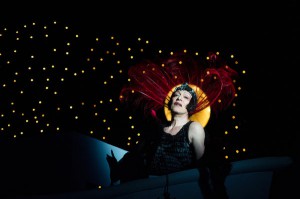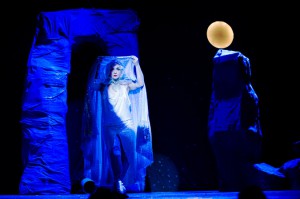By Rachel Straus
Basil Twist’s Sister’s Follies: Between Two Worlds, commissioned for the 100th anniversary of the Abrons Playhouse, is a testament to how camp saves performance history from oblivion. Dance and theater works of yore are notoriously difficult to produce. Their re-staging can look hopelessly old fashioned. But in Sisters’ Follies, Twist—a newly minted MacArthur Genius and a third generation puppeteer—casts Joey Arias, the celebrated drag queen chanteuse, and Julie Atlas Muz, the burlesque performance artist, to play the titular sisters: Alice and Irene Lewisohn, who founded the Playhouse in 1915 as a vehicle for their theatrical ambitions. Muz and Arias are stars of satire, but they aren’t real-life divas (like the Lewisohn sister were). Under Twist’s direction, Muz and Arias become the Lewisohn sisters’ ghosts, floating, flipping and dangling from wires—which divas don’t do. Arias and Muz also prance and preen, belt and belittle each other in the jewel-box size theater, made spectacular through the efforts of 11 behind-the-scenes performers, who manipulate large and small puppets in costumes that range from camels to biblical figures. The Lewisohn’s Playhouse becomes Twist’s camp marionette theater.
Sisters Follies’ homage to the copper heiresses Alice and Irene Lewisohn is, perhaps unintentionally, a meditation about dance versus theater. Alice was the thespian, Irene the terpsichorean. In this satire, they see each other’s chosen art form as the lesser mode of theatrical expression. (It’s nice to see some things never change.) The Jewish sisters resided in New York’s uptown world, yet their Playhouse, on 466 Grand Street, was ground zero of immigrant New York. According to Playhouse scholar John P. Harrington, many of their productions stemmed from the folk tradition of satire. In Sisters Follies, the heart of the show pumps through five satiric cabaret numbers in which Wayne Barker’s mix and match music (a little Dion Warwick, a splash of Rimsky-Korsakov), Arias and Muz’s high-voltage performances, and the puppeteers make merry by spoofing Lewisohn’s successful—and deeply unsuccessful—stage productions, which spanned from 1915-1927.
Twist uses every inch of the tiny Playhouse to evoke the grand vision of the Lewisohn sisters’ theatrical ambitions. Above the proscenium stage, the sculptures of tragedy and comedy (two masked heads) are transformed—through the projection design of Daniel Brodie and Gabriel Aronson—into the faces of the endlessly kibitzing sisters. We learn about how their stage rivalry spurred them to reach new artistic heights. Before this theatrical effect occurs, we see Arias and Muz flying across the stage, like oversize puppets, singing a version of “Sisters” from the 1954 film White Christmas. Irving Berlin’s forgettable lyrics get a remake: Arias and Muz sing, “‘Art is for the masses’ we’re declaring/To this noble purpose she and I sworn/This dream house playhouse was born!”
For the dance writer, the most pleasing number was the “Kairn of Koridwen,” originally performed in 1916, in which Irene starred as a Welsh woman who must choose between love and religion. In a platinum blonde wig and a silver lame gown, Muz (as Irene) demonstrates that she is clearly not from Wales. In Muz’s choreography, she kicks like a Tiller Girl (a precursor of the Rockettes), gestures dramatically à la Isadora Duncan, and then her male object of desire enters on a pogo stick, which immediately calls to mind the famous traveling steps of Tiresias in Martha Graham’s Night Journey. The connection to Graham, who studied at the Playhouse, is furthered by having the chorus, a set of Druids dressed like Darth Vader’s kin (that is if he copulated with an antelope), contract and lunge in unison to a rendition of Charles Griffes atonal music of the day. Muz is so distraught by having to choose between sex and spirituality that she strips down to a G-string. The chorus then lifts her up and, poof, I see Gypsy Rose Lee in all her naked glory. Twist and Muz’s play with historical references is a gas.
Arias’s shining moment occurs in the number “Midnight at the Oasis.” One of the most compelling drag queens working today, Arias also has pipes. When he sings, “I’ll be your belly dancer, prance/And you can be my sheik,” he isn’t just satirizing early 20th century productions like Scheherazade, with its fascination for the “exotic” far east, Arias becomes a pop star in his own right. His vocal range is operatic. His darkly etched eyes and sculpted face bring to mind the disco diva Grace Jones, who like Arias performed with a near violent wish to be seen.
Since Sisters Follies has no narrative or character development, the show grows stale toward the end. Twist tries to keep the momentum by having the sisters’ bickering turn into a full-scale war. They end up throwing a large stick of dynamite at it each other. Finally, it explodes (thanks to a transparent screen that projects a conflagration). Then the unexpected occurs, when Arias and Munoz appear in front of the curtain in their underwear and safety harnesses. Up close their harnesses (for sailing through space) look like S&M gear, which is all too perfect considering the hyper-sexual content of Twist’s production. Breaking the fourth wall, Arias and Muz talk about the joys of playing the Lewisohn sisters because they too were creatures of the theater. Twist’s Sisters Follies is magical performance art. It celebrate the larger than life ambitions of theatrical folk—both today’s and those buried by the passage of time.
To purchase tickets for Sisters Follies: Between Two Worlds before it closes on October 31st go to:
http://www.abronsartscenter.org/performances/basil-twist-sisters-follies.html
Tags: Abrons Playhouse, Alice Lewisohn, Charles Griffes, Daniel Brodie, Gabriel Aronson, Gypsy Rose Lee, Irene Lewisohn, Irving Berlin, Isadora Duncan, Joey Arias, Julie Atlas Muz, Martha Graham, Night Journey, Rachel Straus, Sisters Follies: Between Two Worlds, Tiller Girls, Wayne Barker, White Christmas

